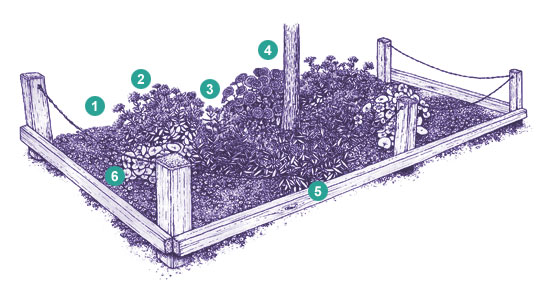A New Tree Bed Garden
Tree beds offer great opportunities for city dwellers to exercise their green thumbs. Passersby appreciate seeing flowers instead of trash around street trees; they may curb their dogs in response. Wilting flowers in the tree bed provide a good reminder to water. As long as gardeners remember that the tree's health always comes first, they can choose from a large palette of annuals, perennials, and bulbs to beautify tree beds.

Perennials
- Thymus praecox (creeping thyme)
3 inches tall; 12 inches wide
This mat-forming tough groundcover has fragrant leaves and clusters of tiny deep pink flowers (attractive to bees) that bloom June through July; let spill onto sidewalk to soften edges.
Zones 4 to 8.
- Sedum'Autumn Joy' (stonecrop)
18 to 24 inches tall; 18 inches wide
The succulent foliage forms a tidy clump, and long-lasting late-summer flowers start pink and mature to rusty red, followed by showy seed heads.
Zones 3 to 10. - Asclepias tuberosa (butterfly weed)
12 to 24 inches tall; 18 inches wide
Spectacular umbels of fiery-orange summer flowers attract monarchs and other butterflies; the narrow green leaves are also a food source for their caterpillars.
Zones 3 to 9. - Scabiosa columbaria 'Butterfly Blue'
(pincushion flower)
12 to 18 inches tall and wide
Showy, profuse, butterfly-luring lavender-blue flowers bloom singly on stiff stems from April until frost; prefers well-drained soil and full sun.
Zones 5 to 9.
Annuals
- Zinnia angustifolia Star Series (zinnia)
9 to 12 inches tall and wide
Drought-tolerant butterfly magnets, these yellow, white, and orange flowers bloom nonstop from June to frost and don't fade in summer heat like other zinnias.
- Tropaeolum majus 'Dwarf Jewel Mix' (nasturtium)
12 to 18 inches tall and wide
Long-stalked rust, orange, and yellow flowers bloom among bushy round foliage from June through October and delight in poor soil. Easy to grow from seed and bloom in just six weeks.
Spring Bulbs
Slip some spring bulbs into the tree bed in fall to provide a flush of color in late winter and early spring before the perennials fill out.
- Eranthis hyemalis (winter aconite)
3 to 6 inches tall and wide
One of the earliest bulbs to bloom, the clumps of little yellow cup-shaped flowers will brighten the tree bed in February and March; plant in groups.
Zones 4 to 7. - Galanthus nivalis(snowdrop)
6 inches tall; 3 inches wide
Nodding white blooms on single stems poke up through the snow in March to herald the approach of spring; great mixed with winter aconite.
Zones 3 to 7. - Tulipa saxatilis(candia tulip)
6 to 9 inches tall and wide
Native to rocky Crete, each stem of this tough, compact species tulip produces up to four stunning rose-lilac flowers with yellow bases in April.
Zones 3 to 8.
The most common mistake made by tree bed gardeners is raising the soil level. Added soil can suffocate tree roots, and moist material piled against bark leads to rot and infection from pests and diseases. Roots can also be damaged by vigorous digging. Instead, use a hand cultivator to gently scratch an inch or two of compost into compacted dirt. The organic matter will break down without raising the bed's level and will gradually improve the tilth of the soil. To conserve moisture and prevent weeds, you can add mulch, leaving a clear space around the tree's trunk. Consider building a safe tree guard (no pointy edges) around the bed that allows rainwater to flow in off the sidewalk.
Many cities are enlarging their tree canopies to clean and cool the air through civic tree-planting programs; for example, New York City and Los Angeles each have initiatives to plant a million new trees (see milliontreesnyc.org and treepeople.org). Newly planted street trees welcome sunloving companions as long as they're not too thirsty-tree bed plants should never be allowed to outcompete the tree for water! Listed here are fairly tough, drought-tolerant plants that enjoy full sun and can stand up to life on the street.


